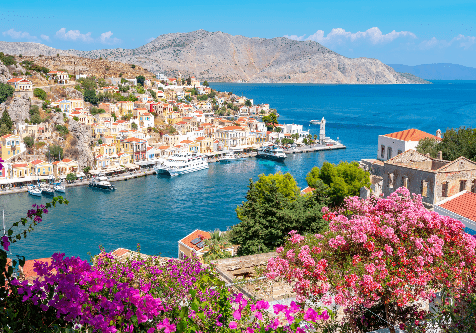Where is the South Aegean Region of Greece?
The South Aegean Region of Greece is made up of:
– the Cyclades islands, and
– the Dodecanese islands
The Cyclades and Dodecanese island groups are located in the central and southeastern Aegean Sea, and make up 4% of the total area of Greece.
The capital of the Cyclades islands is Syros.
The capital of the Dodecanese islands is Rhodes.
The Cyclades
The Cyclades islands are surrounded by the Aegean Sea, and sit just above the Sea of Crete. The name Cyclades, or ‘circular islands’, refers to the islands forming a circle around the sacred island of Delos.
There are approximately 220 islands in the Cyclades; only 33 are inhabited. Interestingly, these 220 islands are actually the peaks of a submerged mountainous terrain (other than Milos and Santorini which are volcanic).
The Cyclades are considered to have some of the most beautiful islands in the world. If you want to see blue and white architecture, quaint villages, turquoise-blue waters, and gorgeous beaches, then these islands have what you’re looking for.
Islands of the Cyclades
Amorgos
Easternmost island; quiet, with beautiful beaches and a lovely main village
Anafi
Small island near Santorini; only one village and untouched by mass tourism
Andros
Close to Athens; second largest island, with beautiful beaches and lush vegetation
Antiparos
Next to Paros; only one village, and many beautiful beaches
Delos
Close to Mykonos; part of the World’s Cultural Heritage, protected by UNESCO
Donoussa
Close to Naxos and Amorgos; very small island with unorganized beaches
Folegandros
Close to Paros and Santorini; quaint and quiet, worth going to Panagia church
Ios
Close to Sikinos; party island, but can also be peaceful, with amazing beaches
Iraklia
Close to Naxos and Ios; small, secluded island, perfect for a calm and relaxing holiday
Kea
An hour from Athens; different architecture, very green and great for nature lovers
Kimolos
Close to Milos; one quaint village, worth the drive to Prassa Beach
Koufonisia
Close to Naxos and Amorgos; made up of two islands separated by a narrow strait
Kythnos
Close to Athens; near Kea and Serifos; with 99 beaches! and four quaint villages
Milos
Close to Folegandros and Sifnos; a volcanic island with magnificent landscapes
Mykonos
Close to Tinos and Syros; partying, shopping, nightlife, restaurants, bars, and beaches
Naxos
Close to Paros; home of Zeus, largest and most fertile island, with amazing beaches
Paros
Close to Naxos; lots of nightlife, wonderful beaches, and lovely villages
Santorini
Most visited Greek island; spectacular views, accommodations, food, and landscape
Schinoussa
Close to Naxos; a small island with unspoilt beaches, great for relaxing and unwinding
Serifos
Close to Kythnos and Sifnos; beautiful beaches, main village has a killer hilltop view
Sifnos
Close to Milos and Serifos; known for its great food
Sikinos
Close to Ios and Folegandros; one of the more secluded and quiet islands
Syros
Close to Mykonos and Tinos; the administrative center for the Cyclades
Tinos
North of Mykonos; 40 villages, Panagia Megalochari church, wonderful beaches
Airports
Santorini
Mykonos
Paros
Naxos, Milos, Syros (domestic flights only)
Agriculture in the Cyclades
Agricultural products in the Cyclades include, fruits, vegetables, honey, wheat, barley, olives, grapes, dairy products, goats, sheep, cattle, and fish. There are also many beautiful wineries and vineyards worth visiting.
Significant Archaeological Sites in the Cyclades
Delos
The island of Delos (near Mykonos) is one of the most important historical sites in Greece. According to Greek mythology, Delos was the birthplace of the god Apollo. The temple of Apollo was therefore built, as well as a theatre. Many of the artifacts are on display at the Archaeological Museum of Delos and the National Archaeological Museum of Athens.
Akrotiri, Santorini
The Akrotiri Minoan site is located on the southern side of Santorini, close to Red Beach. Akrotiri was covered by ashes and lava due to a huge volcanic eruption around 1,650 B.C. This Bronze Age settlement has been preserved beautifully through time, and is known as the Pompeii of Greece.
Portara, Naxos
As you approach Naxos by sea, Portara is the first thing visible on the cliff above the port. Portara is an enormous gate, which is the only remaining artifact of the ancient Temple of Apollo that was constructed in the 6th century B.C. The gate is 6m high and 3.5m wide built with four separate columns. Each column weighs approximately 20 tons. Of the four columns, only three have survived.
The Dodecanese
Even though the name Dodecanese gives the impression that there are only a dozen islands (since ‘dodeca’ in Greek means 12), there are actually a group of 14 larger plus 150 smaller Greek islands and islets.
The Dodecanese are the furthest island group from the Greek mainland, located in the southeastern Aegean Sea off the coast of Turkey. Due to their location, the weather is warmer in the summer and milder in the winter compared to the Cyclades.
Only 26 of the 164 islands are inhabited. These islands have distinctive architectural styles and cultures due to their past Venetian, Ottoman, and Italian rulers. Some have fancy hotels and busy beaches, while others have an authentic and laid-back feel reminiscent of old Greece for those seeking to get away from the crowds.
Islands of the Dodecanese
Astipalea
Has a Cyclades-like feel, Venetian castle, hotels, restaurants, beautiful beaches, quiet
Chalki
Close to Rhodes; untouched by mass tourism, peaceful atmosphere, secluded beaches
Kalymnos
40 min by ferry from Kos; known for sponges, and famous for its rock climbing
Karpathos
Between Rhodes and Crete; beautiful island, village of Olympos, great beaches
Kos
Between Kalymnos and Nisyros; archaeological sites, nightlife, lux hotels, beaches
Leros
Between Patmos and Kalymnos; beautiful beaches, green island, home of Artemis
Lipsi
Between Patmos and Leros; 750 people, green island, beautiful beaches, quiet
Nisyros
Between Kos and Tilos; active volcano, beautiful landscapes, laid back
Patmos
Close to Lipsi; a stop for cruise ships, John wrote the book of Revelation here
Rhodes
As popular as Santorini and Mykonos; medieval walled city, cosmopolitan vibe
Symi
Close to Rhodes; beautiful architecture, pebbled beaches reached by small boats
Tilos
Deserted villages, dramatic landscapes, a spectacular monastery, uncrowded beaches
Kastellorizo (Megisti)
Easternmost tip of Greece just off the coast of Turkey, very authentic, great snorkeling
Airports
Rhodes
Kos
Karpathos
Leros and Kalymnos (domestic flights only)
Agriculture in the Dodecanese
Agricultural products in the Dodecanese include, fruit, cheese, vegetables, legumes, honey, meat, fish. There are also many beautiful wineries and vineyards worth visiting.
Significant Archaeological Sites in the Dodecanese
Medieval Town of Rhodes
The Medieval Town of Rhodes is one of the most important historical monuments in Greece. Today, approximately 6,000 people live and work within the old town. The Upper Town consists of the Palace of the Grand Masters, the Great Hospital, and the Street of the Knights. The Lower Town has a mixture of Gothic period buildings, mosques, public baths, and other buildings dating back to the Ottoman period.
Archaeological Progress in the Dodecanese
Greece’s Ephorate of Antiquities of the Dodecanese has carried out many archaeological excavations and surveys in recent decades. However, archaeology is still a work in progress in the Dodecanese islands.
Rhodes and Kos have been given the greatest attention, but more and more work is being done in smaller places such as Kalymnos, Astypalea, and Gyali. Local museums now exist in many places, such as Astypalea, Kalymnos, Karpathos, Leros, Nisyros, and Symi.
~~~~~~~~~~~~~~~~~~~~~~~~~~~~~~~~~~~~~~~~~~~~~~~~~~~~~~~~~~~~~~~~~~~~~~~~~~~
See some of our South Aegean recipes here.
Do you have a recipe from this region that you love? Share it with us!

